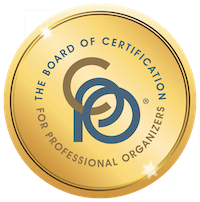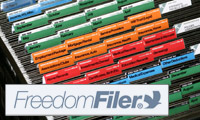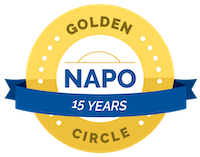Master the art of using business forms
I asked my friend, Geralin Thomas of Metropolitan Organizing in Cary, North Carolina, to write a guest post about how organizers can use forms in their businesses. Geralin has created a set of customizable forms that organizers can purchase, which I think are a great foundation for jumping right into business. (See the link below.) Last month, she spoke about using business forms at the 2018 NAPO Texas Regional Conference for Professional Organizers, so I was really happy when she agreed to share some of her expertise here!

Geralin Thomas
One of my business goals is to help professional organizers and productivity consultants reach their business goals by helping them build sustainable and lucrative organizing businesses. And of all the advice I offer and the skills I teach, there is probably none that helps new business owners more than learning to use forms to run their businesses.
What do I mean by “forms?” A form is a document containing specific fields of variable data. As an example, think of an old-fashioned check. A check is a document with fields where you can enter the date, the amount you want to pay, to whom you want to pay it, and so on. That’s a form: fixed fields with variable data in them.
I use forms with my clients to help them easily achieve their goals. For example, when I work with a client to streamline their wardrobe and create multiple outfits, I provide them with forms to keep track of which pieces work together well. And I designed some complimentary forms for use in your own wardrobe planning, available here.
As a business owner, you can use forms to streamline many daily functions inside your business. One key form is the one used for client intake. When a client calls, you want to give them plenty of space to talk about their needs and why they’ve called you today and what their goals are for working with you. But you also must remember to ask how they prefer to be contacted (work phone or mobile phone?), how they found you (internet search, referral from a past client, advertising, or television appearance?), and whether they have pets in the house, among many other questions.
Business owners want to give their clients and their employees or subcontractors the best possible experience. Using forms saves you from accidentally sending someone with a severe cat allergy out to a house with three cats, a waste of everyone’s time and effort.
Another key form is the client agreement. A clear and concise client agreement helps to ensure that everyone shares the same understanding of what you’ll be doing, what the client will be paying for, and how the relationship will unfold. This can prevent a host of misunderstandings and problems.
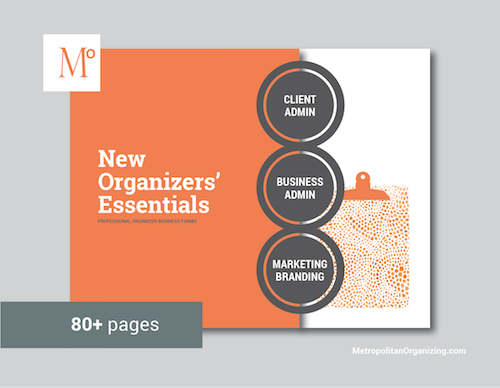
Using forms allows you to “master the art of faster” by handing off jobs more quickly. Your partners, employees, or subcontractors can step in rapidly with no fumbled hand-off. If you agreed to supply storage boxes, everyone knows what size and how many. Multiple people can work on the same job, so the client’s home clean-out project or move happens smoothly, no matter whether you are at the site or not.
Forms create a more consistent experience for your clients, so the service they get from one team is every bit as good as the service from another team.
Using forms will also help you to evaluate what is working for marketing your business and what could be better. If you collect the same information for every contact, you can make an apples-to-apples comparison. This lets you focus on the marketing efforts that gain you the most clients (and the clients you really love to work with!) rather than groping in the dark, trying a lot of random efforts to reach your perfect clients.
If you want to “master the art of faster” and save time and money by using forms, look at the package I offer to new organizers, here. You can customize the forms I offer – which cover client admin, business admin, and marketing and branding – to your brand and your business, so you don’t have to start from scratch.
To make life better for you, your team members, and your clients, master the art of faster by using forms in your business.
Geralin Thomas is a professional organizer and the owner of Metropolitan Organizing based in Cary, North Carolina. Geralin has appeared in an array of national magazines and she’s been featured on A&E’s Hoarders, The Nate Berkus Show, NBC’s The Today Show, CNN, and other outlets. She regularly coaches new organizers privately and teaches classes through the National Association of Productivity and Organizing Professionals.
Another advantage to a minimalist wardrobe: easy packing in a crisis

I had to leave town suddenly over the weekend because my 87-year-old father had an acute health crisis that caused him to be flown to a hospital in Spokane, three hours from his home in Walla Walla, Washington. It resolved quickly, I’m glad to say, and I was able to arrive just in time to drive him home from the hospital and stay with him for a week to take him to his follow up appointments.
There were many reasons to be stressed in the situation after I got the call, but at least I wasn’t stressed about packing. There are so few clothes in my closet that selecting what to wear was a piece of cake. Plus, my travel toiletries kit is always packed, so all I had to do was throw in my electric toothbrush and call Lyft. (Well, and book a flight and rental car.)
I keep finding new ways to appreciate having fewer clothes in my closet!
Worth repeating: Expert clothing advice for women of a certain age
I wrote this post back in 2015. Geralin remains my wardrobe advisor and she never lets me down! I thought this concise advice was definitely worth repeating. I’ll ask Geralin to weigh in on the comments if her advice has changed. Great news! If you’d like the benefit of more wardrobe wisdom from Geralin, you can now purchase her Wardrobe Wisdom Workbook for only $9.99.

Geralin Thomas
As I posted last week, I had a lovely time creating a capsule wardrobe with my friend and wardrobe advisor, Geralin Thomas. Geralin has been helping me with my clothing for eight years and I am so grateful for her expert advice.
In 2007, I was 45 and now I’m 53. In that time, my body has changed somewhat, with a little more padding in the hips than used to be there. That, plus the fact I’m now in my fifties, has changed Geralin’s advice for me a bit.
Last week, she gave me five bits of clothing-selection advice (and permission to share) that is specific to me, but applies to many fifty-something women. (The last one is specific to narrow-on-the top, wider-on-the-bottom women like me.)
- Colors matter. They help simplify the shopping process by ruling some colors out.
- Some colors are so much more flattering than others. Try to shop for colors that match your hair and eye colors and complexion.
- Smaller lapels are less trendy and more classic and therefore have more staying power.
- Thin knits are not so great on many of us as we’re getting older and losing muscle tone, gaining lumps and bumps. Instead, look for thicker knits; ponte knits are especially nice if you’re trying to “glam-oflauge” areas like thighs, bottom, or back-bulge.
- Longer cardigans are not figure friendly for me. Instead, a little structure in a sweater or a jacket helps bring balance.
Geralin always looks amazing and I am delighted that she is so willing to share her wardrobe wisdom. Thank you, Geralin!
From inexpensive glassware to pretty desk accessory
I took a stroll through IKEA the other day, just looking for inspiration and ideas for organizing. I love their home organizing department. But I also love using items intended for other purposes to organize my stuff.
Case in point: I have an extensive collection of pens and markers. My excuse is that I like to color, but the truth is that my coloring markers are upstairs and I still have a hefty supply in my office. I had been storing them in mason jar, along with a bamboo-and-cloth desktop organizer I’d picked up somewhere along the way. It was working fine.
But then, on my stroll through IKEA, I came across GODIS drinking glasses. The shorter, eight-ounce ones seemed perfect for pens. (I pulled a Sharpie out of my purse to check.) So I bought six of them for only $2.99. (That’s the IKEA Family price.) As soon as I got home, I put to them use housing markers and pens. Here’s a photo of how the pens used to be stored and how they look now.

I love that they’re tapered a little so the pens sort of fan out. I like that they’re nearly invisible so all I see are the lovely markers. It feels like a big improvement.
This is a great example of the joy of repurposing an item to help with organizing. Do you have favorite things you like to use for organizing that weren’t originally intended that purpose?
Has someone helped you? Thank them!
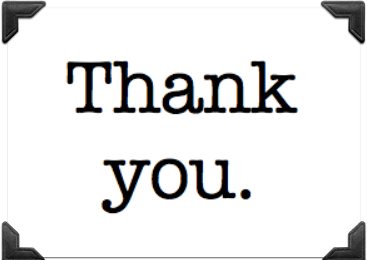
Last Friday, I woke up on the wrong side of the bed. It’s unusual for me to wake up grumpy, but I did. And for the whole morning, I had a black cloud hanging over my head.
Then, about noon, I checked my email. In it was a message from a blog reader named Susan, who started her message with these golden words:
“I wanted to tell you that your blog/advice has made a big difference in my life.”
She went on to describe in detail four areas of her home where she has made progress in decluttering and organizing and what a big impact that has made on her life.
Oh my, I appreciated her message so much! The black cloud over my head lifted, the sun came out and the birds started singing. The fact that she would take the time to let me know that I’ve helped her was so kind.
It got me thinking about the many people whose blogs or books I have read or whose podcasts I have listened to who have made a difference to me. And they have no way of knowing they’ve helped me. Unless I tell them.
So today I encourage you to take a moment and thank someone who has had a positive impact on your life. Trust me, they’ll appreciate it.
Worth repeating: Trying out the KonMari method
The popularity of Marie Kondo and her best-selling book “The Life-Changing Magic of Tidying Up” has not waned since I reviewed her book back in 2015. In fact, Marie Kondo has scored a reality show on Netflix and there were reports of a sitcom based on her. Wow! So I thought it might be interesting to repeat my 2015 post on my impressions of her method when I tried it out on my clothing.
In a blog post earlier this week, I reviewed The Life-Changing Magic of Tidying Up: The Japanese Art of Decluttering and Organizing by Marie Kondo. In this short book—an international bestseller—the author details her KonMari method for decluttering and organizing.
As I wrote in my review there were aspects of the agreed with and aspects I didn’t agree with. But reading the book did make me want to give her methodology a try. The book does a great job of sparking action.
I decided to try out the KonMari method on my clothing. That’s the category that she recommends starting with because it tends to be the easiest category of items to part with. So, as instructed, I gathered up clothing from various storage areas in my house. I keep almost all my clothes in my bedroom, but there were some items in the guest bedroom closet, including out-of-season clothes and some that weren’t fitting when I moved them there.
I emptied all my drawers and shelves and piled everything on the bed. Marie would have had me pile everything on the floor. But in my bedroom, there’s more bed space than floor space. Plus, I didn’t have to bend over to reach the items on my bed. Here’s how my bed looked with all the clothes on it.

I started with the clothes from the guest room closet, because they were the ones I’d worn least recently (per Marie’s instructions). As I touched each item, I asked myself her trademark question, “Does this spark joy?”
I found the question to be very powerful. It’s different from, “How recently have I worn this?” or “Does this look good on me?” There were items in there I had once loved and probably still looked good on me, but they no longer sparked joy. They went right into the donate bag.
I used the app iDonatedIt to keep track of my donations as I put the items in the bag. It was very easy and gave me a little boost as I watched my tax deduction rise. Here’s a photo of the donations:

The whole process took me about 90 minutes (not counting the donation drop off) and when I was finished, I had donated more than half my clothes. What was left easily fit in the drawers and shelves in my bedroom (no more guest room closet for me!) with room to spare. There were items that had been stored in the guest room I’d completely forgotten about and some of them sparked joy. Now I have easy access to them.
I feel absolutely no pangs or worries that I’ll miss any of the items I donated. It’s clear that I still have an abundant amount of clothes. I love that they’re more mindfully stored now.
As an aside, I’ve been using Marie’s folding method for shirts for years. She suggested folding items so that they can be stored vertically, like files. I hadn’t used that method on pants, but today I tried it. So far, I like it quite a lot!
I know how to declutter, obviously. Did using the KonMari method make a difference? It did provide a couple of real advantages:
- The book (and my promise to blog about trying it out) got me to actually take a look at these clothes and bring them together in one spot.
- Working on all my clothes at the same time gave me a sense of completion.
- The question “Does it spark joy?” was very effective at getting me to let go of items without regret.
Of course, the book addresses more than clothing. A couple of days ago, the book inspired me to dispose of a bookshelf full of seminar notes—the handouts that used to be distributed at the conferences I attended (they’re now distributed electronically). That was a little harder; they represented more to me, I think. But I acknowledged that I literally had not looked at any of them after the conference and they were just taking up space. It felt really good to let those go and I have The Life Changing Magic of Tidying Up to thank for it.
I’m still not sure of the practicality of the book’s premise that one should always sort by category not by location—it’s great if you can do it in one session, but what happens if multiple sessions are necessary? it seems to me that you wouldn’t be able to find anything until the process is finished.
Maybe I’ll find out. There are still plenty of areas I can practice on in my own home. In any case, I think I’ll be using the “Does it spark joy?” question with at least some of my clients (giving Marie credit, of course). Perhaps I’ll post more here as I continue on this journey.
Don't give stuff power
In my line of work, I sometimes see relationships that have damaged on account of clutter. I always urge people not to let stuff have the power to affect their lives that way.

Control your stuff, don’t let it control you.
Links
- NAPO St. Louis
- Institute for Challenging Disorganization
- Shannon Wilkinson, life coach
- Peace of Mind Budgeting
- Ravelry
- Organize Your Family History
- Getting to Good Enough podcast
- National Association of Productivity and Organizing Professionals
- Are you interested in becoming a professional organizer?


